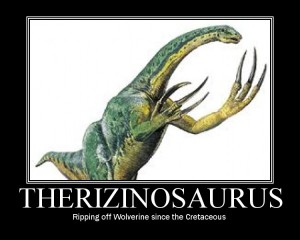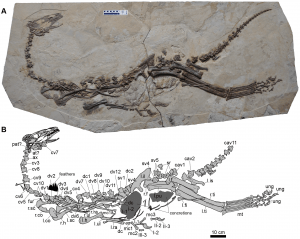‘Meat was so sixty million years agAAAGHH…’
This was initially posted at: http://blogs.egu.eu/palaeoblog/?p=760
Some dinosaurs were utterly bizarre. You may have heard of them before, but one particular group called therizinosaurs belonged to the meat-eating theropod dinosaurs (those that led to birds), were really awesome. However, they actually at some point made a conscious evolutionary decision to stop being badasses, and become Cretaceous-cauliflower* munching pansies.
But to leap from eating meat to eating veggie takes a lot. Ask your veggie friends, while waving a rasher of crispy bacon under their noses how difficult the transition was. While they’re now in tears, consider how difficult that transition must be in evolutionary terms – you have to change the way you eat, in terms of masticatory apparatus, as well as the way you digest, so the co-evolutionary gut biota have to be able to handle an entirely new diet.
So if therizinosaurs descended from these meat-eating theropods, how did they hack it? Well, a new(ish) study reveals that they actually mimicked some of the other cabbage-chomping* dinosaurs, the ornithopods and ceratopsians. These dinos were the beaked members of one of the main groups of plant-eating dinosaurs called ornithishcians, the other being the long-necked sauropods. They were incredibly diverse, ranging from quadrupedal beasts to tiny and nimble fleet-footed snacks, and had a range of feeding morphologies to accompany this.

It has long been known that therizinosaurs er, preyed on plants. A new specimen, known as Jianchingosaurus yixianensis (don’t say with a mouth full of spaghetti), shows a new dimension of complexity to this. Therizinosaurs typically had simple ‘peg-like’ teeth for clipping plant matter. Jianchingosaurus, however, had a slightly more advanced condition, where the back teeth along the cheek, or the more posterior ones along the maxilla in morphology-mumbles, actually contacted each other at the tips. This has the effect of increasing the stress applied to food during biting, and probably enabled them as such to be more efficient at stripping and grinding down tough plant food. This is quite an important step if you can increase the efficiency of such an important task, then you can dedicate more time to watching for predators, mating, or grow bigger, or spend more time at the pub, which dinosaurs may not have done that often.

The important bit about this, though, is that this is the tooth arrangement we find in ceratopsians and ornithopods, the more advanced species of which are renowned for their immense ‘grinding batteries’ of teeth for decimating foliage. Such a novel adaptation may have enabled Jianchingosaurus to live side-by-side with another therizinosaur, Beipiaosaurus, by adopting a different zone of ‘ecospace’ with a different feeding style.

Of course, now being veggiesaurs, it means that these theropods, once big mean hunters were now just seen as prey by the other theropods! I don’t have a clue why therizinosaurs decided to make such a daring leap to become vegetarians – any thoughts on what advantages this might have had for them compared to meatsicles?
*Cauliflowers and cabbages probably didn’t exist 100 million years ago. They might have, but just have a really naff fossil record..
Reference:
Hanyong Pu, Yoshitsugu Kobayashi, Junchang Lu, Yanhua Wu, Huali Chang, Jiming Zhang, Songhai Jia (2013). An unusual basal therizinosaur dinosaur with an ornithischian dental arrangement from northeastern China PLoS ONE, 8 (5) DOI: 10.1371/journal.pone.0063423
![]()
Something would have had to happen to make them need to change their diet, I reckon. I don’t know about the evolution of therozinosaurs, but maybe it could’ve been like a climate change that meant their usual prey disappeared or something like that.
Go outside and tell me what you see more of, plants or animals.
Also, switching diets makes you no more or less of a prey item than you already were.